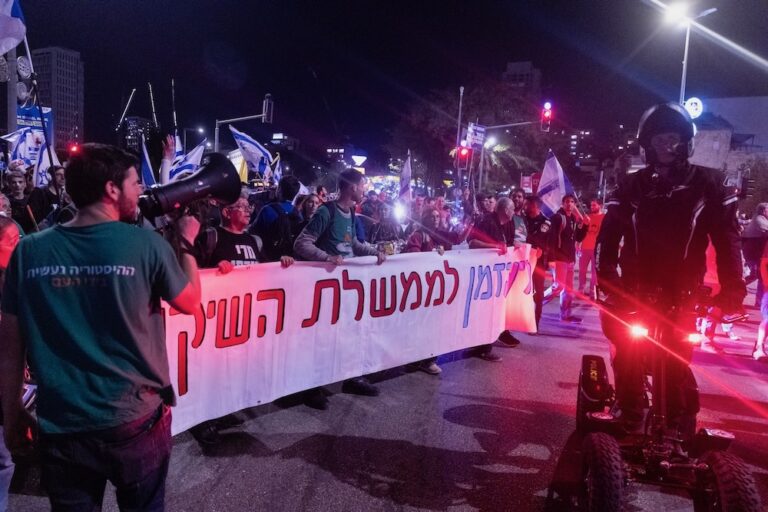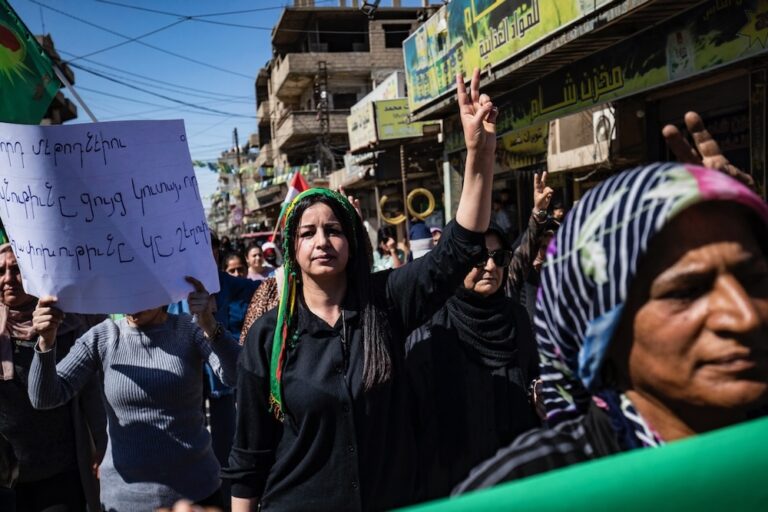(MISA/IFEX) – The following is an abridged 27 April 2007 MISA media statement: Release of MISA’s annual publication, “So this is Democracy? State of the Media in Southern Africa” The Media Institute of Southern Africa (MISA) will again this year be releasing its annual publication, “So this is Democracy? State of the Media in Southern […]
(MISA/IFEX) – The following is an abridged 27 April 2007 MISA media statement:
Release of MISA’s annual publication, “So this is Democracy? State of the Media in Southern Africa”
The Media Institute of Southern Africa (MISA) will again this year be releasing its annual publication, “So this is Democracy? State of the Media in Southern Africa”, in commemoration of World Press Freedom Day on May 3. This is the 13th consecutive year in which MISA has issued this publication, which records incidents of media freedom violations monitored by MISA in the previous year. The current edition therefore details media freedom violations in 2006.
MISA issued 144 alerts in 2006 about press freedom violations in 11 SADC (Southern African Developing Community) countries. The figure marked a decrease of 7.6 percent from the previous year (155). This, however, is an increase of 7 percent over the 84 alerts issued in 1994, when MISA first began monitoring press freedom violations in the sub-continent.
The countries monitored include Angola, Botswana, Lesotho, Malawi, Mozambique, Namibia, South Africa, Swaziland, Tanzania, Zambia and Zimbabwe.
In the regional overview, MISA’s Regional Specialist for Media Freedom Monitoring, Zoé Titus, points out that the death of two journalists in Angola, Augusto Sebastiao Domingos Pedro and Benicio Wedeinge, have left an indelible mark on the psyche of Angolan journalists.
“Official investigations are slow and, while authorities are convinced that these are random incidents unrelated to the work of the journalists, the incidents have left an indelible mark on the psyche of Angolan journalists,” she says.
She spoke at length about the worldwide debate following the publication of cartoons depicting the Prophet Mohammed. Supporters of the ban on the publication of the cartoons argued that the cartoons constituted hate speech, missing the fundamental constitutional point that the media had the right and duty to publish the cartoons, in order to inform the public as to the nature of the debate then raging across the world over the cartoons, she says.
A breakdown of the 144 alerts issued last year shows that 2 journalists were killed, 12 media practitioners were attacked or beaten, one had his properties raided, 22 were detained, three were sentenced, 24 were threatened, 1 was expelled, 24 incidents of censorship were reported, 30 cases of legal action were recorded – where journalists faced legal action or where legislation was passed that affected the media, 17 victories were recorded and a further 8 incidents were reported that proved a violation of freedom of expression that did not necessarily affect the media.
MISA witnessed an overall decrease in “conventional” media freedom violations such as physical attacks, arrests and detentions, and outright attempts to censor media workers. However, a steady increase in criminal and civil defamation suits has created an environment where self-preservation through self-censorship has become common practice.
The majority of criminal defamation cases in the region are in Angola, Lesotho, Malawi, Swaziland, Zambia and Zimbabwe. Zimbabwe is a prime example of the criminalization of media, reinforced by the promulgation of the Access to Information and Protection of Privacy Act (AIPPA), and the Public Order Security Act (POSA) in 2002. It is a criminal offence to publish “false” information prejudicial to the state, or false information adversely affecting the economic interests of Zimbabwe or which undermines public confidence in a law enforcement agency, the prison services or the defence forces of the country. Over 80 journalists have been arrested and three newspapers have been closed down using AIPPA and POSA.
Civil defamation continues to be an effective way of curtailing the role of the press as a public watchdog, by economic attrition. In all jurisdictions in Southern Africa, there is no ceiling on the amount that can be demanded by the plaintiff. This makes civil defamation potentially more damaging than criminal defamation as media institutions are often crippled by the exorbitant legal costs that are often incurred in such matters. In this respect the media in Botswana, Lesotho and Zambia especially face the legal threat of disproportionately high awards given to civil defamation litigants against publishers.
Angola
On February 2, 2006, Angola’s National Assembly approved a new press law, which entered into force on May 15. The new law still contains elements that fall short of international human rights standards. It defines certain conduct as “criminal” in unclear and sweeping terms, and establishes excessive penalties for those crimes, including defamation; it includes provisions that may result in excessive limitations on media freedom; and it provides for the establishment of licensing procedures for private television and radio broadcasters that are largely subject to the discretion of governmental bodies.
In addition, too many key principles and procedures of the law are left for further implementing laws and regulations, and no transitional arrangements are defined to address problems that may arise in the application of the law pending adoption of the implementing legislation. The lack of such laws and regulations makes several provisions of the new press law largely inoperable.
South Africa
There was a significant increase in violations in South Africa, largely due to a number of high-profile court battles that captured the attention of the region. The epic Jacob Zuma trial received unprecedented media coverage and commentary, which did not go unnoticed by the presiding Judge Willem van der Merwe, who in his judgment chastised those who had breached the sub judice rule. In so doing, Judge Van der Merwe set the tone for what was to follow: a barrage of civil defamation claims by Zuma against a long list of publishers, editors, newspaper titles, reporters and a cartoonist for their coverage and comment on his rape trial.
The debate around South Africa’s Film and Publications Act is set to proceed in 2007. Media freedom watchdogs have warned that print and broadcast media could be the subject of strict censorship if changes to the act proposed by the home affairs department became law.
The Film and Publications Act regulates films and publications by censorship, and currently has a clause that exempts the news media from its provisions, enabling print and broadcast news to operate without interference. The proposed amendment includes bringing news media under the act, which means both print and broadcast media would be subjected to the dictates of the Film and Publications Board, a censorship body. As such the effect of the amendment would be the subjection of the media to prepublication censorship.
Zimbabwe
In an already repressive media environment where such laws as AIPPA, POSA and the Broadcasting Services Act (BSA) remain firmly entrenched in the statutes, Zimbabwean authorities tabled the Interception of Communications Bill 2006. It empowers the chief of defence intelligence, the director-general of the Central Intelligence Organisation, the Commissioner of Police and the Commissioner General of the Zimbabwe Revenue Authority to intercept telephonic, e-mail and cellular telephone messages.
At the end of 2006, MISA and the Friedrich Ebert Stiftung (FES) completed the first round of African Media Barometer (AMB) surveys in the 11 SADC countries where MISA is active: Angola, Botswana, Lesotho, Malawi, Mozambique, Namibia, South Africa, Swaziland, Tanzania, Zambia and Zimbabwe. The AMB is an assessment tool of the national media environments. A collective panel of media and civil society representatives assess their national environments according to 42 defined indicators. The benchmarks used are largely lifted from the African Commission for Human and Peoples’ Rights’ Declaration of Principles of Freedom of Expression, adopted in 2002.
None of the countries under review have a media landscape that rated as predominantly free and independent. In southern Africa, South Africa came closest to this standard. For the rest, a lack of confidence prevails in the national broadcasters, and their relevance in the promotion of participatory development and democratisation. National and regional campaigns for broadcasting reform should therefore be prioritised.
In all, 2006 has been a year of hard knocks for the media in SADC. Whilst numerous victories were recorded with respect to legal judgments, these came at great cost to media institutions and individuals.
May 3 is celebrated this year at a time when the media in Zimbabwe is facing its darkest hour. The deepening crisis in that country requires a level of solidarity by all journalists in the region for it has become apparent that we cannot look to our governments for relief.
Journalists and free expression activists should therefore rally behind one another especially where it concerns the unlawful arrest, detention, assault and torture of colleagues as these actions not only go beyond the hazards that come with the terrain of the profession, but also blatantly violate the charters, conventions and declarations that protect media freedom and freedom of expression.
(. . . )
MISA thanks all its national chapters in the 11 SADC countries for the contributions they made in the reporting of media freedom violations in their countries to the MISA Regional Secretariat in Windhoek. These violations form the basis of many regional and international campaigns to draw attention to media freedom abuses in various countries and to provide protection for media practitioners who are under threat.
COPIES OF THE BOOK MAY BE ORDERED FROM: The Communications Manager, Windhoek, Namibia, Tel. +264 61 232 975, Fax. +264 61 248 016, e-mail: communications@misa.org or alternatively downloaded from our website: http://www.misa.org


